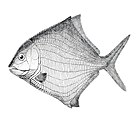
Acipenseriformes is an order of basal ray-finned fishes that includes living and fossil sturgeons and paddlefishes (Acipenseroidei), as well as the extinct families Chondrosteidae and Peipiaosteidae. They are the second earliest diverging group of living ray-finned fish after the bichirs. Despite being early diverging, they are highly derived, having only weakly ossified skeletons that are mostly made of cartilage, and in modern representatives highly modified skulls.
Chondrostei is a group of non-neopterygian ray-finned fish. While the term originally referred to the paraphyletic grouping of all non-neopterygian ray-finned fish, it was redefined by Patterson in 1982 to be a clade comprising the Acipenseriformes and their extinct relatives.
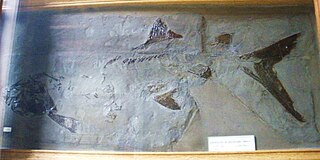
Chondrosteus is a genus of extinct marine actinopterygian belonging to the family Chondrosteidae. It lived during the Hettangian and Sinemurian in what is now England. Chondrosteus is related to sturgeons and paddlefishes as part of the clade Acipenseriformes, and is one of the earliest known definitive members of the group. Similar to sturgeons, the jaws of Chondrosteus were free from the rest of the skull. Its scale cover was reduced to the upper lobe of the caudal fin like in paddlefish.
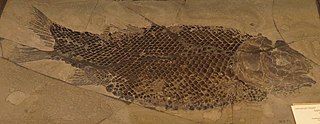
Lepidotes is an extinct genus of Mesozoic ray-finned fish. It has long been considered a wastebasket taxon, characterised by "general features, such as thick rhomboid scales and, for most of the species, by semi-tritorial or strongly tritorial dentition". with dozens of species assigned to it. Fossils attributed to Lepidotes have been found in Jurassic and Cretaceous rocks worldwide. It has been argued that Lepidotes should be restricted to species closely related to the type species L. gigas, which are only known from the Early Jurassic of Western and Central Europe, with most other species being not closely related, with other species transferred to new genera such as Scheenstia.Lepidotes belongs to Ginglymodi, a clade of fish whose only living representatives are the gars (Lepisosteidae). The type species L. gigas and close relatives are thought to be members of the family Lepidotidae, part of the order Lepisosteiformes within Ginglymodi, with other species occupying various other positions within Ginglymodi.

The Palaeonisciformes, commonly known as "palaeoniscoids" are an extinct grouping of primitive ray-finned fish (Actinopterygii), spanning from the Silurian/Devonian to the Cretaceous. They are generally considered paraphyletic, but their exact relationships to living ray-finned fish are uncertain. While some and perhaps most palaeoniscoids likely belong to the stem-group of Actinopteryii, it has been suggested that some may belong to the crown group, with some of these possibly related to Cladistia and/or Chondrostei. Many palaeoniscoids share a conservative body shape and a similar arrangement of skull bones.

Dicellopyge is an extinct genus of freshwater ray-finned fish that lived during the early Anisian age of the Middle Triassic epoch in what is now South Africa. It was originally named "Dicellopygae" by James Brough but the name was later corrected to Dicellopyge by Peter Hutchinson.

Cornuboniscus is an extinct genus of prehistoric freshwater ray-finned fish that lived during the Pennsylvanian epoch (Carboniferous), and the only member of the family Cornuboniscidae. It contains a single species, C. budensis from the Bashkirian/lower Westphalian age of what is now Cornwall, England. The genus Cornubonisus was named after the island of Cornubian, and the species name refers to the coastal town of Bude in Cornwall. The type specimen is held in the town's Castle Heritage Centre.
Scanilepis is an extinct genus of prehistoric bony fish that lived during the Rhaetian-?Hettangian ages. The type species, S. dubia, is known from the Rhaetian freshwater deposits of the Bjuv member of the Höganäs Formation, southwestern Sweden. A second species, S. spitzbergensis was mentioned from the Hettangian of the Festning section of the Grøfjorden area in Spitsbergen, Norway but was never described.

Anaethalion is an extinct genus of prehistoric marine and freshwater ray-finned fish related to modern tarpons and ladyfish. It is known from the Late Jurassic to the Early Cretaceous of Europe and northeasterrn Asia, roughly encompassing the Tethys Ocean.
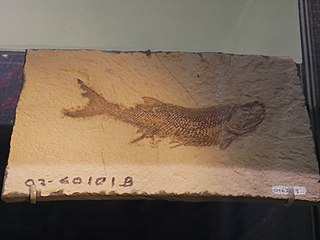
Cyranorhis is an extinct genus of prehistoric marine ray-finned fish that lived during the Serpukhovian age of the Carboniferous period. One species is known, C. bergeraci in the Bear Gulch Limestone what is now Montana, United States. It is named after French novelist Cyrano de Bergerac.
Cycloptychius is an extinct genus of prehistoric freshwater & marine ray-finned fish that existed throughout much of the Carboniferous period in Eurasia, and possibly into the Early Permian in South Africa. It was a member of the Rhadinichthyidae, a family of basal ray-finned fish that was formerly placed in the now-paraphyletic order Palaeonisciformes.

Coccolepis is an extinct genus of prehistoric marine ray-finned fish in the family Coccolepididae. Originally including most species within the family, it is now restricted to two species from the Late Jurassic Solnhofen Limestone of Germany. The holotype of C. bucklandi, designated and described by Louis Agassiz, was thought to be lost but was later rediscovered in Neuchâtel.
Ceramurus is an extinct genus of prehistoric marine ray-finned fish from the Late Jurassic. It contains a single species, C. macrocephalus from the Purbeck Group of England.
Decazella is an extinct genus of prehistoric freshwater ray-finned fish that lived during the late Carboniferous period. It contains a single species, D. vetteri from the Gzhelian (Stephanian) age of what is now Occitania, France.
Plesiococcolepis is an extinct genus of prehistoric ray-finned fish. It belongs to the family Coccolepididae and is known from the Early Jurassic of Lingling-Hengyang, Hunan, China.
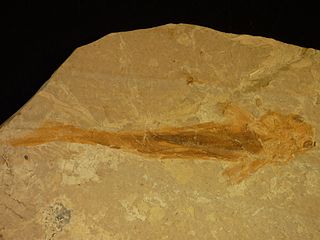
Peipiaosteus is an extinct genus of prehistoric chondrostean ray-finned fish. Its fossils are found in the Early Cretaceous Jiufotang Formation, Pani Lake, Liaoning Province, China.

Squaloraja is an extinct genus of bizarre ray-like marine chimaeriform fish from the Early Jurassic of Europe.

Morrolepis is an extinct genus of prehistoric coccolepidid "palaeoniscoid" ray-finned fish that lived during the Late Jurassic and earliest Cretaceous epochs in Europe, Asia and North America.
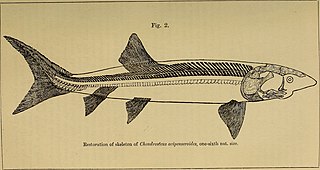
Chondrosteidae is a family of extinct marine actinopterygian fishes, known from the Early Jurassic of Europe. They are closely related to modern sturgeons and paddlefish of the order Acipenseriformes, and are either placed as part of that order or the separate order Chondrosteiformes within the Chondrostei. Three genera are known, Chondrosteus, Gyrosteus, and Strongylosteus. Included species were of large size, with body lengths ranging from 2 metres (6.6 ft) up to 7 metres (23 ft). Their skeleton was largely made up of bones, but ossification was reduced compared to other ray-fins.

Coccolepididae is an extinct family of ray-finned fish, known from the Early Jurassic to Early Cretaceous, most of which were originally referred to the type genus Coccolepis. They had a widespread distribution, being found in North and South America, Australia, Asia and Europe. They are mostly known from freshwater environments, though several species have been found in marine environments. They are morphologically conservative, and have poorly ossified endo and exoskeletons, which usually results in poor preservation. This makes it difficult to distinguish species. They are generally small fish, with the largest known specimens reaching a length of 210 mm. Historically, they have been classified as members of “Palaeonisciformes”, a paraphyletic grouping of non-neopterygian fish, due to their plesiomorphic conservative morphology closely resembling those of many other groups of primitive fish. Some recent authors have suggested that they may belong to the order Chondrostei as relatives of the Acipenseriformes.




















